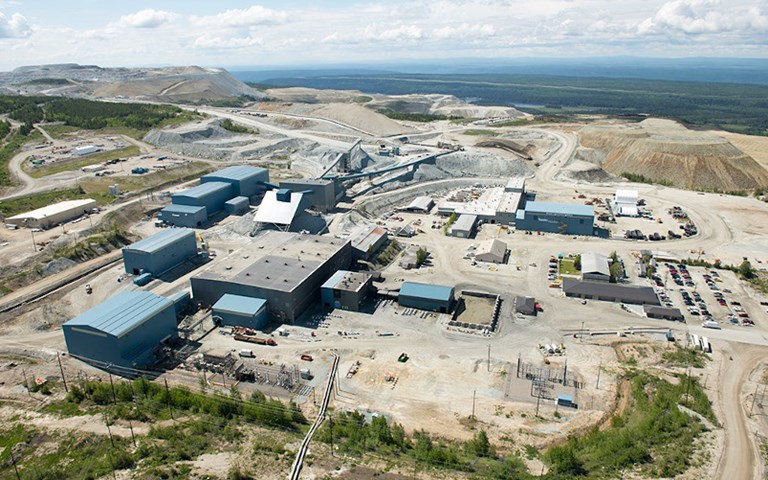Taseko was granted British Columbia's top mine reclamation award for its collaborative efforts at its Gibraltar copper mine. Courtesy of Taseko.
(Like what you’re reading? Get our weekly recap delivered straight to your inbox each Friday.)
Welcome back to your weekly mining news recap, where we catch you up on some of the news you may have missed. This week’s headlines include Syncrude Canada testing a new water-treatment method for oil sands tailings ponds, Minodahmun Development launching a work training program for northern Ontario First Nations and CIM updating its 2015 Commodity Pricing guidance.
The Northwest Territories Public Health office has closed its investigation into the positive COVID-19 case of a Diavik diamond mine worker, as reported by CBC. According to health officials, the outbreak risk is resolved, as the 21 close contacts who had been isolating have now been released and there is no heightened risk to local communities. Plans are being made to send the worker, who tested positive upon arrival at the mine on September 10, home to Ontario.
Dominion Diamond Mines announced it plans to restart its Ekati diamond mine in the Northwest Territories after accepting a $166-million cash bid to exit creditor protection, as reported by CBC. Under the bid, the company will sell substantially all of its assets related to the mine to Canadian Diamond Holdings, LP and CA Canadian Diamond Mines ULC, which will also assume the mine’s operating liabilities, including offering positions to Dominion’s employees and pension obligations. The bid will need to be approved by the court and will need to reach an agreement with the Northwest Territories government on reclamation obligations before the transaction is completed.
A federal prosecutor is stating that Vale has not complied with commitments it made regarding its tailings storage facilities in Brazil, as reported by Reuters. According to Brazilian prosecutor Edison Vitorelli, Vale has repeatedly failed to take preventative and proactive safety measures despite promising to improve its tailings dam safety procedures following the Brumadinho disaster of last year. Vitorelli also stated that 29 of the company’s tailings dams in the country are elevated safety risks. The company has denied these allegations, stating that it has documentation that proves it promptly addresses possible risks and is on schedule to fulfill its commitments to prosecutors.
Syncrude Canada is testing a new water-treatment method for oil sands tailings ponds at its facility in northern Alberta. The company started its multi-year field pilot last year to test the new technology, which uses petroleum coke to treat oil sands process water, in the hopes of one day returning the water to the Athabasca River. According to the company, the technology removes suspended solids such as clay, reduces the level of naphthenic acid and has the potential to treat eight million to 12 million cubic metres of water per year.
The British Columbia Technical Research Committee on Reclamation has awarded Taseko Mines with the Jake McDonald Annual Award for Metal Mine Reclamation for the reclamation work at its Gibraltar copper mine in south-central British Columbia. According to the committee, Taseko won the award due to its collaborative research programs, such as the company’s scientific work on soil microbial communities and its salmon sampling program in partnership with the local Xatśūll First Nation and Northern Shuswap Tribal Council.
Tartisan Resources has completed a review and re-estimation of nickel and copper resources at its Kenbridge deposit in northwestern Ontario, which was mined for two and a half years in the 1950s. The updated resource estimate of the deposit showed a measured and indicated resource of 7.58 million tonnes at 0.58 per cent nickel and 0.32 per cent copper and a total of 95 million pounds of contained nickel. The company is preparing an exploration and drilling program, as well as a new preliminary economic assessment of the deposit.
CIM’s Mineral Resources and Mineral Reserves Committee has updated its 2015 Commodity Pricing guidance. The updates include removing out of date text, streamlining definitions of several metal pricing assumption methods, such as consensus prices and contract pricing, and cutting references to standards from American agencies. The 2020 CIM Guidance on Commodity Pricing is available online.
Minodahmun Development has launched its new Readiness and Essential Skills for Employment Training program to train members of the Aroland, Animbiigoo Zaagi'igan Anishinaabek and Ginoogaming First Nations for mining and construction jobs in the Ring of Fire, as reported by CBC. Funded by the Ontario government and Greenstone Gold Mines, the project aims to boost the local Indigenous workforce in mining and construction by providing employment and training at Greenstone’s Hardrock gold project.
While Indigenous engagement is now critical to resource development, some Indigenous Nations do not have the resources or capacity to engage with the consultation process effectively. Corporations have used asset management systems to maintain and effectively use their assets. With more provincial authorities encouraging municipalities to adopt them, these systems are an attractive option for Indigenous Nations, as well, writes environmental professional Hannah Burke. Developing and implementing asset management systems can help Indigenous communities manage their unique assets and to improve the consultation process.
NORCAT and Vale have partnered to launch the NORCAT Open Innovation Challenge to accelerate innovation and the rate of technology adoption in the mining industry, as reported by International Mining. The challenge is open to start-ups and entrepreneurs who will present technological solutions to the issues of smelter acid management, underground operator alertness and excessive water leading to run of material in underground mines. Applicants must be able to develop and deploy a proof-of-concept at one of Vale’s Sudbury operations by March 2021.
If you’ve got feedback, you can always reach us at editor@cim.org. If you’ve got something to add, why not join the conversation at our Facebook, Twitter or LinkedIn pages? Like your recap with a few more gifs? Check out our mining news recap stories on our Instagram.
Remember to stay safe, keep your distance and wash your hands!



